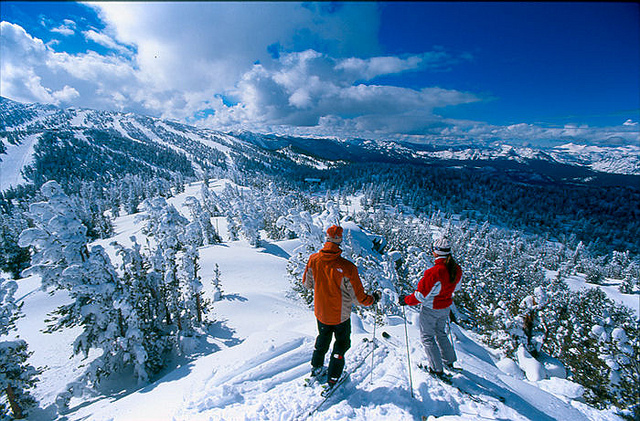When I lived in the Rocky Mountains, as soon as fall arrived and the crisp, cool weather settled in, I began to think about the powder days ahead.
Now that I live far from the mountains, I still get that tingle inside once fall hits.
Now, because I have the experience of skiing over 100 days a year for over 15 years, I know just how important it is to prepare the body for the rigors of the sport. I know just how to train so that I have the strength, balance, and endurance needed for my ski holiday.
Yoga is the perfect cross-training tool to prepare for days on the slopes.
Just as with yoga, skiing is meant to be equal parts effort and ease. In yoga the dance is between the inhalation and the exhalation, creation and dissolution. In skiing the dance is between the constant fine tuning and precision within each turn and the letting-go quality of heading down the hill with beauty and grace.
Yoga and skiing also happen to require a lot of balance.
In yoga, the standing and balancing poses train the body, to find balance between gravity (grounding/rooting action) and rebounding force (equal and opposite uplifting reaction). In skiing you play with the same forces of nature—gravity, which pulls you down the hill, and rebounding action, which allows the ski to move through the snow into and out of the turn.
Yoga trains the body to become strong, like a diamond. The book Hatha Yoga Pradipika has laid out the path to achieving the “diamond body.” The diamond body can withstand any climate, stave off any illness, and digest any food. It is pure and clean and contains vital living force that is in tune with nature’s forces.
The skier needs to have rock solid musculature of the legs and hips, a strong core and back, and be able to adjust to any and all conditions with reflexes like a cat. If the skier follows the instructions of the Pradipika, she will attain ultimate physical conditioning.
So, with the slopes in mind, here are some yoga exercises that will keep you in balance and upright on your skis.
1. Chair Pose
Utilizing the quad strengthening component to this posture, the shape mimics the shape of the body while skiing.
Adding some dynamic movement up to standing and back into the squatting position increases the strengthening aspect to this exercise.
2. Lunge (Three variations)
Begin with the classical version to find the stretch throughout the hips, hip flexors, and low back.
Then, take the top of the foot down and lift the knee off the floor to strengthen the quadriceps muscles in an elongated position.
Then, tuck the toes back under and lift the thigh and knee up away from the floor.
These exercises tone the lower limbs and create the endurance necessary for long days on the hill.
3. Lunge with Twist
Going into the classical lunge variation, stretch the torso up away from the hips and twist toward your front leg.
“Hook” your opposite elbow outside of the front thigh. Bringing the palms of the hands together, thumbs at the sternum bone, spin the navel, ribs, and chest up.
Look up.
Spinal flexibility and core mobility is crucial for injury prevention on the slopes.
4. Tree Pose
Standing on one leg while balancing is difficult enough. Add the downhill momentum of skiing, even on two feet, and you can begin to understand the importance of this exercise.
Stand upright. Shift the weight to one foot. Bring the sole of the opposite foot up to the inner calf or thigh.
Take the hands at your hips, or over the head.
When you become really proficient, close your eyes and imagine yourself zooming down the hill. Make sure you balance on each leg for an equal amount of time. Work up to a minute on each side.
5. Warrior III
This position continues to work on balancing aspects, while adding strength and endurance for the back.
Stand upright. Reach the arms overhead, or keep them by your sides.
Tilt the body forward and the non-standing leg, up and back.
Bring the body and back leg to horizontal. Switch legs and work each leg for up to a minute.
6. Move from Tree to Warrior III (dynamic balance in motion)
Skiing is a dynamic balancing sport. You are moving, actually hurtling, yourself downhill at increasing speeds and inclines as your skills improve. This exercise trains your mind to adapt to the shifts that occur while moving and balancing.
Start in tree position. Hold for a four breath count (improve your concentration by actually counting your breaths and staying with the count fully in your mind’s eye), then move to Warrior III and hold for four breaths.
The US Ski Team members I have worked with could maintain focus and balance throughout this exercise with their eyes closed the entire time! Give it a try!
7. Locust
Core and back strength are crucial for a day on the slopes. The spine takes a lot of torque while turning the skis as the body absorbs gravity, centrifugal and centripetal forces of nature.
Lie on your belly with the arms by your sides. Lift the whole body up off the floor. Hold for eight breaths.
Rest. Repeat.
8. Reclining Hip Opener
Strong musculature around the hip joints prevents injuries, but a certain amount of flexibility in that same hip musculature will prevent injuries around the knee joint.
Lie on your back with bent knees, feet on the floor. Take one foot and place the ankle across the opposite thigh. Push the knee away from the body.
If you need a bit more stretch, bring the foot and thigh that is on the floor toward you by interlacing your fingers at the back of the thigh and pulling the leg toward the torso.
If your head and low back lift off the floor, go back to the first version.
9. Happy Baby
Relaxation is always necessary and tightness in the hips prevents the mind from quieting. This is a nice exercise to find release in the low back and hips.
Lie on your back. Bend the knees and grab the soles of the feet.
Pull the thighs down toward the floor outside of the torso.
Close the eyes and find sensation. Imagine your breath entering and loosening up any and all tightness you might be feeling.
10. Reclining Spinal Twist
Release the spine, tone the abdomen, prepare for final relaxation.
Lie on your back. Bend one knee and place the foot outside of the straight leg knee.
Take the bent leg across the body and down. Twist the torso in the opposite direction.
Hold for four breaths. Repeat on the other side.
11. Final Relaxation/Savasana
If there is only one “pose” you should do every day, for the rest of your life, it is this one. Become a master of relaxation. It will not only help you recover from your workout or day on the slopes, but it can help you recover from a day at the office and prepare you for whatever difficult emotional life situation you might encounter.
Lie on your back. Feel the pull of gravity. Tune into that sensation of body moving downward into earth.
Keep going, little by little, body part by body part. Notice the sensation of your body weight as it “settles down” and into the earth’s embrace.
Let go. Rest. Let the body go. Rest.
Let the thoughts and the mind go. Rest.
Let the breath go. Rest.
When you feel lighter and free of body/mind attachments, move slowly onto your side.
From there, when you are ready, sit up.
Take a moment, or two or 10, sitting upright in silence, watching, listening, tuning into your own inner nature.
As Maria Rainer Rilke offers: “The inner. What is it?”
From the beauty of outer nature, listen and follow her advice. Move with the natural forces. Listen to the inner force of the heart’s wisdom.
Strength and awareness in and around the core of the body, our solar plexus region, allows us to remain upright, standing firmly between earth/snow and sky, or moving downhill with grace and ease.
Yoga has laid it all out for us as to how to achieve maximum physical harmony and balance with nature.
Prepare yourself as best you can by following the principles of the Hatha Yoga Pradipika and good luck both on and off the slopes!
Love elephant and want to go steady?
Sign up for our (curated) daily and weekly newsletters!
Author: Charry Morris
Apprentice Editor: Guenevere Neufeld / Editor: Catherine Monkman
Photo: Ridge Tahoe Resort Hotel











Read 0 comments and reply